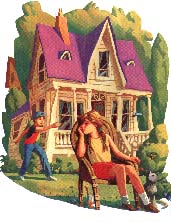|
________________
CM . . . .
Volume VI Number 21 . . . . June 23, 2000
excerpt: "No one understands," Polly grumbled. She picked up her kitten, Pierrette, and clomped up the stairs to her room. She called Clementine, her Very Best Friend and Next-Door Neighbour, to come over at once.  Polly is obsessed with thoughts of Paris. She longs with all her heart to be in alluring Paris rather
than in her humdrum hometown of Periwinkle. Despite begging her mother twice daily, Polly's
ambition to see Paris seems unobtainable, and so she and her best friend Clementine hatch a plan
to run away to France. En route, however, as Periwinkle grows smaller through the bus window,
the girls fall silent, thinking of their homes. At the end of the line, they agree that they're not
ready, make a secret pact to visit Paris when they're older, and ride the same bus back to
Periwinkle.
Polly is obsessed with thoughts of Paris. She longs with all her heart to be in alluring Paris rather
than in her humdrum hometown of Periwinkle. Despite begging her mother twice daily, Polly's
ambition to see Paris seems unobtainable, and so she and her best friend Clementine hatch a plan
to run away to France. En route, however, as Periwinkle grows smaller through the bus window,
the girls fall silent, thinking of their homes. At the end of the line, they agree that they're not
ready, make a secret pact to visit Paris when they're older, and ride the same bus back to
Periwinkle.Images of the Eiffel Tower abound, usually in grey, while Polly's actual environment is in full-colour. Renowned painter Rudolf Stuessi has depicted the Paris of the 1950's as the Paris of Polly's dreams. Objects in his illustrations are slanted and distorted with a non-conforming energy that mirrors Polly's rampant imagination. Sometimes her dreams take over the illustrations, as they have taken over her life. For instance, when Polly ascends the staircase to her room, she starts on an ordinary bottom landing but continues towards a full-colour Parisienne street scene which occupies the whole right page. The author and illustrator have together captured the adventurous yearnings of a young girl and make her sudden change of heart understandable. In the text, Eisenstein dwells on all the things she loves about home while Stuessi reverses his colour versus grey composition so that the bus on which Polly is travelling becomes grey whereas the images of home floating around her are in full-colour. The last double-page spread of Polly's being welcomed home by her mother with outstretched arms is reminiscent of Max's return from the land of the Wild Things to a warm supper, an act which signifies the unconditional love of a mother. My problem with this book is its intended audience, which the publisher suggests to be ages 5-8. What primary child is obsessed with a foreign city? The illustrator, perhaps grappling with this question, has depicted Polly and Clementine as pre-adolescents, but this age group is not usually drawn to picture books. Older children, however, will probably enjoy this story with its wonky cartoon-style illustrations. Recommended with Reservations. Alison Mews is Director of the Curriculum Materials Centre, Faculty of Education, Memorial University of Newfoundland.
To comment on this title or this review, send mail to cm@umanitoba.ca.
Copyright © the Manitoba Library Association.
Reproduction for personal use is permitted only if this copyright notice
is maintained. Any other reproduction is prohibited without
permission.
Published by
TABLE OF CONTENTS FOR THIS ISSUE - June 23, 2000.
AUTHORS |
TITLES |
MEDIA REVIEWS |
PROFILES |
BACK ISSUES |
SEARCH |
ORDER |
CMARCHIVE |
HOME
|
